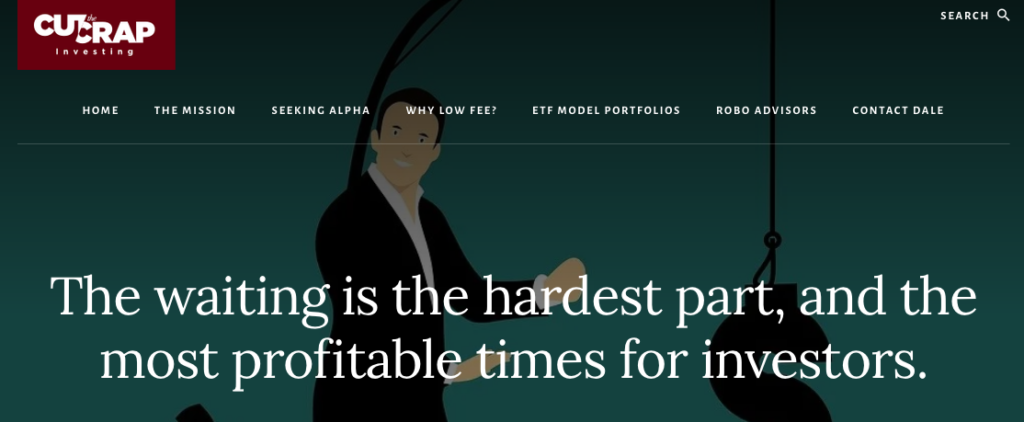By Dale Roberts
Special to Financial Independence Hub
Investors are starting to notice that their portfolios have been treading water for a couple of years. Over the last two years, a global balanced growth portfolio would essentially be flat. Of course, move out to 3-year, 5-year and 10-year time horizons and we have very solid to generous returns.
At times investors have to wait. We build and springload the portfolio waiting for the next aggressive move higher. In fact, these holding periods can be beneficial: we are loading up on stocks at stagnating or lower prices. We’re able to buy more shares. The waiting is the hardest part for investors. But it is essential that we understand the benefits to sticking to our investment plan.
In January of 2021 I wondered aloud in a MoneySense post if the markets might not like what they see when we get to the other side of the pandemic. That’s an interesting post that looks back at the year 2020, the year the world changed with the first modern day pandemic. That suspicion is ‘kinda’ playing out as the markets stall and try to figure things out.
That’s not to suggest that my hunch was an investable idea. We have to stay invested.
Stick to your plan when the market gets stuck
Patience is the most important practice when it comes to wealth building. When done correctly, building life-changing wealth happens in slow motion and it is VERY boring.
Boring is good.
Waiting can be boring. But maybe it can look and feel more ‘exciting’ if we know what usually happens after the wait. Stock markets work like evolution. There are long periods of stagnation and status quo and then rapid moves and change.
Instead of boring, maybe it should feel like a kid waiting for Christmas. The good stuff is on its way.
Here’s an example of a waiting period, from 1999. The chart is from iShares, for the TSX 60 (XIU/TSX). The returns include dividend reinvestment.

And here’s the stock market ‘explosion’ after the wait.

That’s more than a double from the beginning of the waiting period.
And here’s the wait from 2007, moving through the financial crisis. Ya, that’s a 7-year wait. Talk about the 7-year itch, many investors filed for divorce from the markets.

It was a costly divorce.

Markets went on a very nice run for several years.
Here are the returns over the last 3 years. You can see the stall from the Fall of 2021.

The markets can get ahead of themselves and then they have to catch their breath. Fears and rising risk can cause investors to hold onto their wallets, causing a stall or decline. It’s a normal event. Stalls can be brief or last many years.
To put it into visual perspective here’s the lifetime chart and table for the XIU ETF.

If I had started with that long-term chart, you’d probaby think that investing is quite easy and peaceful and consistent. Almost 8% over 1 year, over 10% annual over 3 years, 8% annual over 5 years? Sure, sign me up.
The roller coster ride to the sky
But it’s not that simple. Think of stock markets as a roller coaster ride that goes into the sky. It moves up over time, quite aggressively. That said, past roller coaster rides do not guarantee the direction of future roller coaster rides. But I like our chances.
Keep investing. That’s the ticket. Admit one to financial freedom, your family’s financial freedom and security. And what waits in the sky (that considerable portfolio) is just heavenly to exhaust my analogies. It’s life changing.
Of course, you need very good savings habits. Here’s my post on the financial planning basics. That post is entitled – Oh look, I just found $888,000 in your coffee.
The more we invest, the more we make to state the obvious.
Keep it simple. Keep it cheap.
Most would agree that costs are the most important part of investing. Fees are wealth destroyers, along with taxes and bad investor behaviour. It is crucial to do the ‘minimal’ amount of research required so that you can go it alone – without an advisor that will likely charge you 2% annual or more when you include the fund fees.
Buy ETFs for free at Questrade
Diversification is important. While there are many ways to wealth creation here’s a look at the returns for simple and cost-effective ETF portfolios.
Here’s a video on the investment basics and portfolio construction.
There are even all-in-one, global asset allocation ETFs.
Many self-directed investors use a mix of individual stock portfolios working in concert with ETFs. I’m in that camp. But the rules are the same. Keep on keepin’ on during the doldrums and when markets are roaring.

As always, ensure that you understand and invest within your comfort level for volatility. You have to get on the right roller coaster. Also, ensure that you understand all tax implications. Wealth building in the accumulation stage can be simple. We fill our RRSPs and TFSAs and then taxable accounts if we’re fortunate enough to have even more investable dollars for hire. Sign up for your employer’s matched money group plan and accept all free monies.
Please feel free to reach out via the Contact Form on my blog. Want to learn how to build a portfolio, how to leave your advisor? Fire away.
It’s different in retirement. That’s why retirees hold bonds, cash and GICs. In retirement we grow and protect. You can use the search tool on this blog for retirement posts.
You can follow this Cut The Crap Investing, it’s free. You’ll receive notices of new posts plus additional content. Enter your email address in the Subscribe area.
 Dale Roberts is the owner operator of the Cut The Crap Investing blog, and a columnist for MoneySense. This blog originally appeared on Cut the Crap Investing on Sept. 12, 2023 and is republished on the Hub with permission.
Dale Roberts is the owner operator of the Cut The Crap Investing blog, and a columnist for MoneySense. This blog originally appeared on Cut the Crap Investing on Sept. 12, 2023 and is republished on the Hub with permission.


